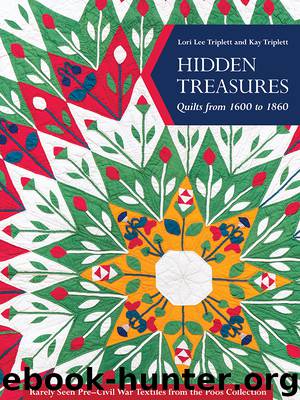Hidden Treasures, Quilts from 1600 to 1860 by Lori Lee Triplett

Author:Lori Lee Triplett
Language: eng
Format: epub
Publisher: C&T Publishing
Circle
This quilt’s unique pattern is enough to require a second look at the star, whose edges seem to bend. The wonderful quilting is a double row in the border and in the blocks, alternating with a grid.
Block
PAPER-PIECED QUILTS
Hexagon Diamonds Quilt, American, c. 1850, 103˝ × 114½˝
An extraordinary large fussy-cut hexagon pieced quilt. Hexagon size measures ½˝.
Paper piecing is the method of wrapping fabric around a paper shape, such as a hexagon, to stitch the shapes together. (In contrast, foundation piecing is the technique of using fabric or paper as a base layer to stabilize the fabric while stitching the pieces. Foundation piecing is sometimes called string piecing, as it is often used for patterns with small strips.) The transatlantic technology transfer of paper piecing from England to colonial America occurred in the mid-1700s.71 Therefore, in America, the technique has continued to be called English paper piecing to distinguish between machine paper (foundation) piecing and hand piecing with shaped papers.
However, the technique is not exclusive to England; it has been used in a variety of countries. The earliest known pieced item is a handmade fifteenth-century Italian cushion. The “Impruneta cushion” was used as a coffin pillow for the head of Bishop Antonio degli Agli, a priest at Santa Maria dell’Impruneta from 1439 to 1477.72 The earliest dated paper-pieced quilt is a 1718 silk coverlet currently housed at the American Museum in Bath, England.
Paper piecing seems to have started with squares, with variations added as quilt artists explored new ideas. In the mid- to late 1700s, geometry primers became available, providing information on how to draw different geometric shapes.73 Several early British and American quilts still have their papers intact and show the penciled, hand-drawn shapes instead of the precut pieces often used today.
Additionally, many of the early paper pieces are not exact in their design. Some of the quilts show a square cut unevenly into quarters and stitched into (quarter-square triangles) hourglass shapes. The curved piecing in several of the early quilts does not match well in size or shape, providing examples of hand-created papers instead of machine-cut papers. Further proof of the individualistic approach to paper piecing is the existence of many quilts using this method prior to any known publication of a pattern. Hexagons begin appearing in quilts in the late 1700s, but the first published hexagon pattern was found in an 1835 Godey’s Lady’s Book.74
Download
This site does not store any files on its server. We only index and link to content provided by other sites. Please contact the content providers to delete copyright contents if any and email us, we'll remove relevant links or contents immediately.
On Writing A Memoir of the Craft by Stephen King(4863)
The Doodle Revolution by Sunni Brown(4685)
A Simplified Life by Emily Ley(4099)
Mummy Knew by Lisa James(3631)
Marijuana Grower's Handbook by Ed Rosenthal(3619)
Better Homes and Gardens New Cookbook by Better Homes & Gardens(3524)
Figure Drawing for Artists by Steve Huston(3381)
Paper Parties by Erin Hung(3370)
Draw Your Day by Samantha Dion Baker(3288)
The Genius of Japanese Carpentry by Azby Brown(3224)
Japanese Design by Patricia J. Graham(3109)
The Code Book by Simon Singh(3074)
Dangerous Girls by Haas Abigail(2976)
Lions and Lace by Meagan Mckinney(2923)
The Curated Closet by Anuschka Rees(2913)
How to Make Your Own Soap by Sally Hornsey(2827)
The Checklist Manifesto by Atul Gawande(2776)
The Wardrobe Wakeup by Lois Joy Johnson(2732)
Zero to Make by David Lang(2726)
